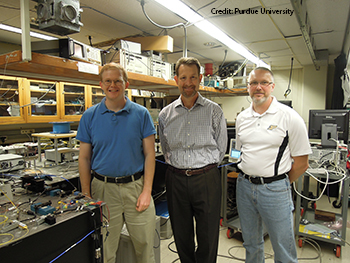
Coauthors (left to right): Joseph M. Lukens, Andrew M. Weiner and Daniel E. Leaird.
Just as metamaterials experts have been learning how to hide objects in space, other researchers are trying to conceal signals in the time domain. Several U.S. researchers have demonstrated a “temporal cloak” that works at a realistic data rate for telecommunications (Nature 498, 205).
Three scientists at Purdue University (U.S.A.) built the cloak out of off-the-shelf optical components, such as phase modulators and chirped fiber Bragg gratings. The cloak is a temporal version of the so-called Talbot effect, which in the spatial domain regenerates the image of a diffraction grating at certain periodic distances from the grating.
In the experiment, the team set up pairs of pulse modulators in front of and behind an intensity modulator, which sent out a sinusoidal signal representing the “event” to be cloaked. When the researchers turned on the cloak, it made “holes” in the signal that concealed the signal, similar to the way that metamaterials divert light around obstacles in order to hide them.
According to lead author Joseph M. Lukens, a Purdue graduate student in electrical and computer engineering, the experimental results are getting close to the point of practical application in fields such as cybersecurity, thanks to the speed of the method and the use of widely available components.
More research must be done, however, to make the cloak into a commercial product. “For example, our cloak applies to a single wavelength, whereas in the future one would like to be able to handle a fiber link that holds multiple data streams,” Lukens says. “Additionally, at present the cloak does not provide a means to send the data to a second receiver while the first receiver is cloaked (it simply hides the data from one recipient). With more research, it should be possible to cloak the data stream along one channel, but then simultaneously send it faithfully to someone else along another.”
